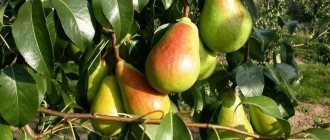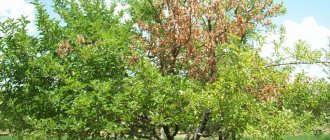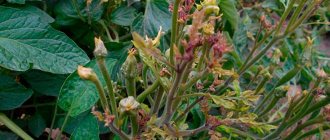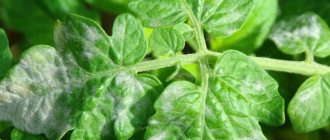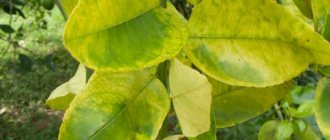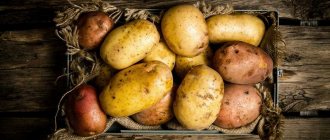The pear tree requires special agricultural care and temperature conditions. The southern regions are considered the most favorable areas for growing this crop. However, a number of breeding varieties, subject to high-quality compliance with agrotechnical recommendations, make it possible to obtain a pear harvest even in the northern parts of Russia. Sometimes, despite proper care, the pear may begin to dry out. Having determined the reason why the branches of the pear dry, you can get rid of this problem.
List of reasons for pear drying
There is a list consisting of a number of reasons why a pear dries and what to do in order to cure it.
Violation of agricultural practices for care and planting
Compared to the apple tree, the pear is considered a more demanding plant in terms of agricultural technology and planting conditions. The pear tree should be planted on an elevated area or on the top of a slope. For healthy development, the pear requires loose soil, permeable and capable of air permeability, as well as low groundwater. The planting area is prepared in the fall, with uniform application of fertilizers and careful digging. Acidified soil is neutralized with lime. The width of the planting recess for the pear is one meter, the depth is just over half a meter.
Why does the pear dry out?
When planting in autumn, the base of the roots is located at ground level, when planting in spring - 4 centimeters higher. If you plant a pear tree correctly, it will grow and produce abundant harvests. But, if the place where the trunk becomes part of the root system turns out to be uncovered with soil, this can lead to the drying out of the pear. The root area may be open for two reasons:
- pushing out a tree due to soil freezing;
- incorrect landing.
In these two cases, the base of the root system should be sprinkled with soil.
Note. Planting a pear tree in clay soil that has a dense structure, with nearby crushed stone and sand layers, as well as construction waste, will lead to a shortened lifespan of the tree and low quality of the harvest.
Groundwater should not lie at a distance closer than one and a half meters. In particular, stagnant groundwater affects trees that have a tap root system that can penetrate more than two meters deep into the soil. High groundwater levels contribute to disruption of air exchange. Small-sized roots receive almost no oxygen, which leads to the fact that the root system begins to dry out; water does not reach the upper crown part of the pear, which is why the plant stops growing and dies.
Due to excessive acidification and salinity of the soil composition, the processes of growth and development of the planting are disrupted for 8 years. Otherwise, the tree may die immediately.
The most common mistakes made by gardeners when planting pears, the time for which is most often spring, which can lead to the plant drying out, are:
- the reason for the incorrect placement of the base of the root system;
- graft location error;
- refusal to create a drainage layer;
- the planting hole is not wide enough, leading to intertwining of roots.
On a note! Another reason could be improper watering. Often, gardeners who do not have sufficient experience, seeing dried branches, begin to over-water the trees, mistaking this phenomenon for a lack of water in the soil.
Violation of the condition of the rhizome
Often the area where the trunk transitions to the root is taken as the grafting site. This part of the plant should visually disappear underground, but not very deep. Sometimes the established low air temperature causes the upper part of the root system to appear above the soil surface. This deformation leads to a stop in the growth of the pear and the cessation of its ability to bear fruit. This situation can be corrected by filling the root area with soil and, if damaged areas occur, covering them with a composition consisting of a mixture of clay and manure.
Violation of the condition of the pear rhizome
Unsuitable weather conditions
The pear tree is particularly susceptible to excessive soil moisture. The drying out of small branches is considered the first sign indicating a violation of the condition of the root system. Despite the fact that water is a source of nutrients for the plant, its excess can lead to the death of the plant.
Pear blossoms occur earlier than other trees. Thus, repeated frosts can kill the young ovary tissue, buds and spring pear blossoms, causing them to immediately begin to turn black and wither. This is precisely the reason that varieties intended for cultivation in the southern regions do not bloom in the regions of central Russia, despite the annual formation of flower buds.
Important! A pear tree cannot be called cold-resistant - even in the first weeks of winter its roots can freeze. You can prevent freezing of the roots by covering the ground around the perimeter of the crown part with a thick layer of mulch, spruce branches and dense covering materials.
Also, the pear may stop bearing fruit due to exposure to strong icy winds. Damage to the planting for this reason can be prevented by enclosing the garden with a high fence.
The emergence of pests and diseases
There are many pests and diseases that damage pear trees, stunt their growth and reduce productivity. In advanced stages of the disease, plants die.
The pear may begin to dry out if it becomes infected with the following diseases:
- scab;
- powdery mildew;
- black leaf spot;
- cytosporosis;
- moniliosis;
- brown leaf spot.
On a note! Scab disease is a rather dangerous reason why pears wither. Scab affects every single leaf, ovary and the pear fruit itself. Thus, damaged leaves and ovaries fall off, shoot growth slows down or stops completely. Favorable conditions for the spread of scab are cool weather with high levels of air humidity, as well as long, prolonged rains. During this period, the leaves become covered with small black spots, which grow over time, the diameter of which can be several centimeters. With severe damage to foliage, the quantitative and qualitative indicators of yield are significantly reduced.
Small-sized fruits have a bland taste and dry texture. The scab can also spread to the green branch, on which many gray-green spots appear. Sometimes the twig becomes covered with wounds that gradually increase in size, which can cause it to dry out and die. When fruits become infected with scab, they become covered with dark, velvety, growing spots that harden and crack. Fallen leaves serve as overwintering sites for fungal bacteria.
On a note! Moles can also damage pear trees. Their presence can indicate soil collapse when walking. Also, watering with a hose can easily wash away soil from the root system. You can fight moles by flooding their tunnels, or by burying special “noisemakers.”
Known diseases
If you find signs of bacterial, fungal and viral diseases on the pear, you should carry out a complete treatment of the garden. Many infections spread very easily - literally with a blow of the wind, so remote planting does not fully protect against problems. Regular prevention should be carried out in spring and autumn. Compliance with this rule is the key to success.
Attention! When treating plants in the garden with chemicals, pay attention to the expiration date of the active component of the drug. In the case of fruit trees, treatment is limited to harvesting - interventions are stopped at least 21 days before due to the risk of producing “poisonous” fruits.
Information about viral diseases can be found in the following video.
Fungal infections of pears
Pears are most susceptible to fungal diseases. Pathogens develop well and form powerful colonies in warm and damp conditions. Periodic pruning helps reduce the risk of spores spreading. The main cause of many diseases is the thickening of the crown.
Trees should not be placed in poorly ventilated areas. It is important to keep the ground under the fruit tree clean, promptly removing fallen leaves and fruits. They should not just be removed from the ground, but burned, and then the area should be dug up.
The cause of infection can be pests, so treatment in the spring with a complex of insecticidal and fungicidal preparations is most relevant.
Sooty fungus
This disease is also known by another name - yellow lichen. Appears as a noticeable dark coating. Spots similar to soot form on the leaf blades. They cover shoots and fruits.
Sooty fungus is actively observed at the stage of fruit formation. The pears themselves lose their presentation and are inferior in taste to healthy ones. If the problem is ignored for a long time, the growth rate of the crop changes, the development of shoots slows down, and the yield decreases.
If detected in a timely manner, the problem can be eliminated without chemical treatment. It is enough to take a damp cloth and remove the plaque with it. In this case, areas with massive lesions are removed and burned.
If the disease has spread significantly, it is impossible to do without the use of chemicals. Medicines for treating pears against sooty fungus:
- "Skor";
- "Strobe";
- "Horus";
- "Fury"
- "Shepra";
- "Decis".
Traditional methods are used to combat fungus. The shoots are wiped with a beer or alcohol solution. It’s interesting, but these methods work and show good results if all recommendations are followed.
Scab
The causative agent of pear scab is the fungus Venturia pirina. It shows its activity in conditions of high humidity. The first symptoms become noticeable with the onset of warm weather, and traces of the activity of the pathogenic organism can be seen on the underside of young leaves in late spring or early summer.
The danger is that the disease affects not only the leaf blades. It quickly spreads to shoots, flowers and fruits. It is necessary to carefully inspect the plants periodically.
If you ignore the problem and do not treat it, the tree will become covered with black-brown spots that resemble warts in appearance, which can merge into large areas of necrosis.
Looking at photos of pear leaf diseases, you can see some similarities between scab and phyllostictosis.
Most often, preparations containing copper are used to combat pear scab. The fungus quickly dies from contact with it. The main caveat is that these agents are contact agents; accordingly, the activity of the pathogen will be suppressed only at the site of the reaction where the component comes into contact with the spores.
Leaf rust
Rust is the most common damage to pears. Its symptoms appear sharply, and the state of the culture rapidly deteriorates. Noticeable tan (red) spots form on the surface of the leaves in spring. They grow quickly, darken and become covered with a gray-brown coating.
If you miss this phase, a growth or thickening will form on the back of the sheet. All the signs of this pear disease are visible in the photo.
Before starting an active fight against the disease, a “cleaning” is carried out. Remove all affected leaves and branches and then burn them. The soil around the plant is dug up. Further treatment is reduced to the use of systemic drugs - fungicides. Existing sections are treated with a solution of copper sulfate.
Cytosporosis
With this lesion, the bark on the branches of the plant quickly dries out, its shade noticeably changes, and gray bulges appear on the surface. The fungus is localized in them. The causative agent is Cytospora microspora.
In the spring, after the buds open, the affected branches and trees quickly dry out, and the infection itself remains in the bark.
It is very difficult to eliminate the problem, so it is better to initially follow the agrotechnical standards for growing pears on a personal plot. Trees must be protected from cytosporosis by regular treatments. If foci are detected, the affected areas are removed and burned, the plant is sprayed with a solution of Bordeaux mixture with a concentration of 1% or its analogues.
Fruit rot
Fruit rot or moniliosis is a dangerous disease that affects not only pears. It quickly spreads throughout the garden, affecting apple, cherry, sweet cherry, cherry plum and plum trees. Losses can be enormous, often reaching 80% of the total crop weight. The danger lies in the active spread of Monilla fructigena. Spores are carried by insects, as well as by rain and wind.
To combat the problem, biological, chemical and folk methods are used. The best results are achieved when using fungicides. The preparations “Horus” and “Skor” are effective, but processing the green mass alone is not enough. You can't do without watering. Fruits affected by rot must be disposed of.
Black cancer
Black cancer or Antonov's fire is a common and very dangerous fungal infection that appears on pome trees - apples and pears. The causative agent is Sphaeropsis malorum. The spores overwinter in fallen fruits and leaves, under healthy bark and remain active for 3-4 years.
Lesions cover the trunk, leaves, flowers and fruits. Infection of skeletal branches is considered dangerous. The bark of the tree in places where the fungus is active becomes stained, “charred” and cracks.
Next, the integumentary part dies off and the wood turns black. The diseased areas expand rapidly, dead tissue envelops the branches and trunk of the tree in a ring. First the shoots die, and then the whole pear.
Attention! Mature plants can be lost in just 3-4 years.
In the early stages (before looping), treatment is possible. The affected bark, including the healthy one, is cleaned and the area is disinfected with a solution of copper sulfate at the rate of 300 g of product per 10 liters of water. Next, the area is covered with garden varnish.
In case of a voluminous lesion, the area is “sealed” with putty made of clay and fresh mullein, mixed in a 1:1 ratio. This scheme can be used in early spring and late autumn, the air temperature should be about 13 degrees Celsius.
White spot
Septoria or white spot of pear is another common fungal disease that significantly reduces the plant's immunity. Against the background of its activity, frost resistance suffers, the tree weakens, and leaf fall begins early.
During the growing season, shoot growth decreases significantly. Lesions are most noticeable on young leaves. You can see the characteristic symptoms in the photograph.
Attention! Symptoms of septoria should be looked for on plants in May, when consistently warm weather sets in.
To eradicate the problem, treatment with fungicidal preparations is necessary:
- "Fundazol";
- "Skor";
- "Previkur";
- "Ordan"
- "Acrobat";
- "Oxychom";
- "Kuproksat";
- "Rovral";
- "Profit".
The first event is carried out before the buds open. Repeated treatment is planned after the growth of green mass, and the third - upon completion of flowering. One cycle does not guarantee complete elimination of the disease. It is better to alternate medications, changing the active substance.
Powdery mildew
The fungus Podosphaera leucotricha most often parasitizes apple trees, but can also affect pears. The symptoms are similar:
- a white coating appears on the inflorescences;
- shoots are deformed;
- leaves dry out;
- fruit formation decreases;
- At first, the coating is light and darkens over time.
To eliminate powdery mildew, fungicidal agents are used. Effective prevention is ensured by treatment at the beginning of the growing season - two sprays are enough. During treatment, treatments are carried out more often. The following drugs are used:
- "Tiovit";
- "Jet";
- "Raek";
- "Topaz";
- "Moon";
- "Horus."
The optimal interval between procedures is 1-2 weeks.
Phyllosticosis
The more common name for the disease is brown spot. Its occurrence is provoked by the fungus Sphaeropsidales. The lesion can be seen on the leaf blades. Dark brown or gray spots of indeterminate shape form on them. They are located remotely from each other and can later merge.
Noticeable black dots appear on the surface of the leaves. Peak spotting occurs in early summer. In conditions of warmth and moisture, active progress is possible.
For treatment, spraying with Bordeaux mixture or analogue drugs is carried out. It is not recommended to use compounds containing copper to combat the problem. They are ineffective and even dangerous. It is known from authoritative sources that such drugs can aggravate the course of phyllostictosis.
Drying of the top of the pear tree
The plum is drying up: what to do
Dryness manifests itself in the drying of young shoots of branches and the upper tier of the crown. This problem can be observed in the spring or summer seasons. There are four reasons for the top of a pear to dry out:
- disturbed agricultural technology;
- irrational application of fertilizers;
- developed disease;
- the appearance of pests.
Drying of the top of the pear tree
Treatment to treat dryness
There are special treatment methods for different reasons:
- If the reason why the pear dries out from above is a violation of agricultural technology, then a number of measures will be a way to get rid of this problem, including deoxidation of the soil composition by adding dolomite flour, planting seedlings on a raised ridge, creating drainage ditches between the rows, getting rid of pests such as moles, as well as the selection of a varietal variety, the cultivation of which corresponds to the conditions of the specific garden plot where the tree will be planted;
- In case of irrational application of fertilizers, the treatment method will depend on the presence or excess of a particular element. You can reduce the concentration of boron in the soil when the top of a pear seedling has dried out by adding phosphorus and calcium. Boron deficiency is eliminated by adding this element. Copper deficiency can be corrected by using copper-containing fertilizers. If there is a deficiency of zinc, you can use a folk remedy - sow the necessary green manure before winter;
- The phenomenon when the top begins to dry out can be caused by some disease; it can be prevented by taking preventive measures, which consist of treating the garden plot with chemical-based preparations such as Topaz, Horus or Ordan. For bacterial burns, antibiotics are used. However, the best measure in such a situation would be to remove and burn diseased branches;
- The tops may dry out due to the influence of pests - in this case, some insecticide, such as Aktara or Karbofos, should be sprayed into the cracks in the bark, and then the crack should be filled with cement or garden varnish.
Treatment to treat dryness
Drooping branches and drying leaves
If the branches of a pear droop and dry, and the leaves dry out, this is a symptom of a disease such as bacterial burn. The reasons why a garden pear drops its branches and why the pear subsequently dies are the transfer of this infection from a diseased tree to a healthy one, as well as high air humidity at moderate air temperatures.
Strawberries and berries are drying, what to do?
In addition, the disease can be transmitted by rainfall or insects. This disease can be treated in three ways:
- removing the diseased tree in order to prevent further spread of the disease throughout the garden;
- treatment with the antibiotic drug “Streptomycin”;
- wood treatment with Bordeaux mixture.
Note! If the pear was able to bloom and bloom, but the leaves dry out, then, as in the case of the reason described above, accompanied by drooping branches, this is a symptom of a bacterial burn. This disease can be treated by following the instructions on what to do: the pear dies from a bacterial burn, indicated in the previous paragraph.
Why do pear trees have limp and deformed leaves?
The pear is 5 years old, planted on the sunny side, the pear has not been exposed to any diseases before. When new leaves appear, increased deformation is observed, as well as limp foliage, and puffiness is observed on some leaves. Water the pear regularly. Krasnodar region.
Pear Pear 2 Pear 3
Maxim, I don’t insist on droplets of verticillium, ttt, let us all pass this scourge!)) BUT! Still, regarding the drying of the leaves - I agree, but this is a different stage, some time after the wilting... But let’s skip the wilt, ok, that’s not it!
Leaf rollers? I have 5 pears on the plot and I saw their activity, there are real tubes, often several nearby leaves are grabbed, and there is also a cobweb inside and, in fact, the caterpillar itself. Aphids? and where are the aphids themselves? The author of the question claims that no pests have been noticed on the leaves. You can really see aphids without a magnifying glass, can’t you? Where is the stickiness on the leaves or swellings that occur during the activity of various aphids?
Maybe it's some kind of mites, but what kind? because of some there are cobwebs, because of others there are swellings-galls, you can look for mites with a magnifying glass... BI-58 does not seem to be an acaricide, should they remain alive? And if it’s a virus, what kind? Well, we need to figure it out... The tree looks simply epic(((
Source
Drying of the central trunk of the pear
The reasons that the stem part of the pear tree, which represents the central organ of this plant, has begun to dry out may be a number of factors:
- low temperatures in the winter season;
- incorrect dosage of nitrogen fertilizer;
- appearance of insects;
- fungal diseases;
- solar exposure;
- physical deformities;
- the appearance of rodents.
On a note! There are a number of gardening activities on how you can save a wilted pear trunk. To do this, you need to collect the necessary gardening tools and start restoring the healthy state of the bark:
- if there are cracks in the spring, you should begin to strip the dry trunk of both three-year-old trees and older trees using a disinfected knife;
- you can also furrow the bark by making 2-millimeter-thick cuts on it using a garden knife;
- Another measure is whitewashing the trunk;
- You can protect the trunk from frost by wrapping it in newsprint;
- It is recommended to treat the wood with a solution of copper sulfate;
- You can also use fungicidal preparations to treat the trunk.
Drying of the central trunk of the pear
Precautions against drying out
When the pear dries, you can find out what to do from the information below. The first thing you need to understand is the exact cause of drying out. Naturally, if it can actually be done. When this cannot be determined in any way, then each of the points listed above is checked.
Treatment with chemicals
You can treat with chemicals if there are fungi on the pear or if insects are found. The easiest way to overcome the problem is if prevention and spraying are performed. For therapeutic treatments, copper-containing preparations or fungicidal agents are used. Among the effective drugs are antibacterial ones. Insecticidal preparations work well against parasites:
- Bi-58.
- Decis Pro.
- Tetrix.
- Aktara.
The solution is made only according to the instructions, then the pear is processed. Several secondary treatments may be required to correct the problem. It is necessary to carefully monitor the condition of the plants. Control chemicals should not be used after color is complete.
Remove injured parts. Tools must be disinfected before and after work.
Unconventional methods
Wood ash is considered a popular non-traditional remedy. This is both feeding and protection against parasites. In the form of an infusion, it is used for wet treatments; dry ash is sprinkled on the branches and the area near the trunk. Garlic or onion infusion helps against mites, aphids and for the prevention of fungi. Diluted regular soda is used much less frequently, but it is used at the first symptoms of powdery mildew or fungi on the foliage. The use of infusions from:
- Autumn walnut leaves.
- Tobacco.
- Wormwood.
All of these drugs are preventive and help fight harmful insects.
Treatment of dry pear with biological products
Today, unique biological products have appeared. Processing alone is not enough. Biological products are most often unstable and quickly decompose when exposed to the sun. The Fitoverm series is excellent for killing parasites. This also includes:
- Aktofit.
- Spark-bio.
- Agravertine.
Against fungal infections, for preventive purposes use:
- Gamair.
- Alirin-B.
- Planriz.
- Fitosporin-M.
Bactorodencid helps against mice.
Advice from experienced gardeners
Gardeners who have some experience in growing pear trees say that it is possible to prevent the death of a tree from drying out if you take a number of preventive measures:
- collect and burn fallen leaves in a timely manner;
- thin out the thickened crown after flowering and fruit set have ended;
- treat root areas of the soil;
- spray the planting using Bordeaux mixture, copper oxychloride and colloidal sulfur;
- plant varieties intended for cultivation in a given region, capable of surviving not only the summer - hot June and July, but also low temperatures in winter.
This material listed all the reasons why the pear dries out and what to do to fix it. A pear tree can begin to dry out for a number of reasons. However, by correctly identifying the symptoms of why the pear dries, you can eliminate any of them. By following the recommendations of professional gardeners, you can completely avoid this problem.
0 0 votes
Article rating
Prevention
Preventive protective measures must be carried out throughout the growing season:
- plant varieties resistant to diseases and pests;
- follow agricultural practices;
- provide balanced nutrition to the plant;
- thin out dense branches;
- treat gum wounds;
- carry out autumn and spring digging of the soil;
- disinfect the soil with Bordeaux mixture, copper sulfate;
- destroy weeds;
- spray pears with protective agents;
- burn fallen leaves and sawn branches in the fall;
- clean the trunk and branches of the tree with a brush with iron bristles;
- whitewash the trunk and branches in the spring and before winter sleep;
- to activate the immune system, spray pears with immunostimulants Zircon, Albit, Bud, Epin-Extra;
- before opening the buds, spray the tree with a 3% solution of Bordeaux mixture against fungal diseases and lichens;
- when unfolding leaves, carry out summer spraying with 10% karbofos against sucking and leaf-eating insects;
- after flowering, treat with a 1% solution of Bordeaux mixture against scab;
- three weeks after the end of flowering, install pest traps.

